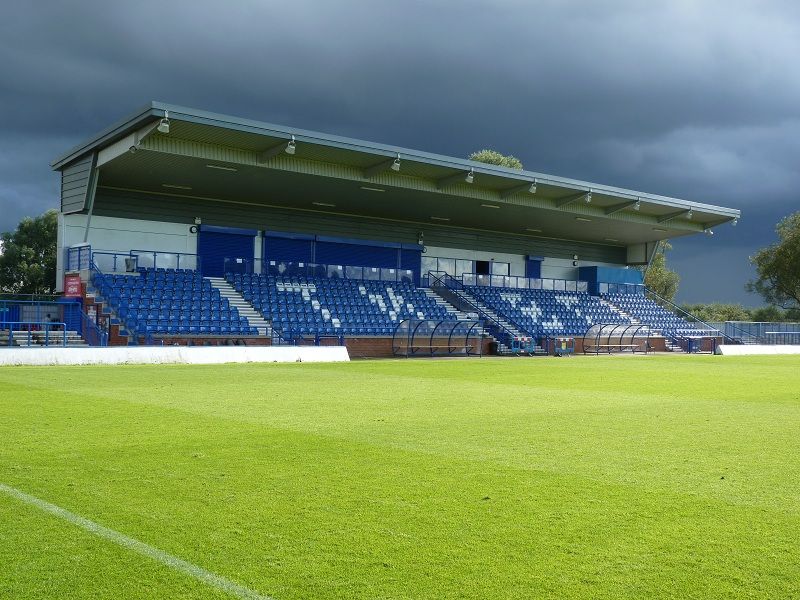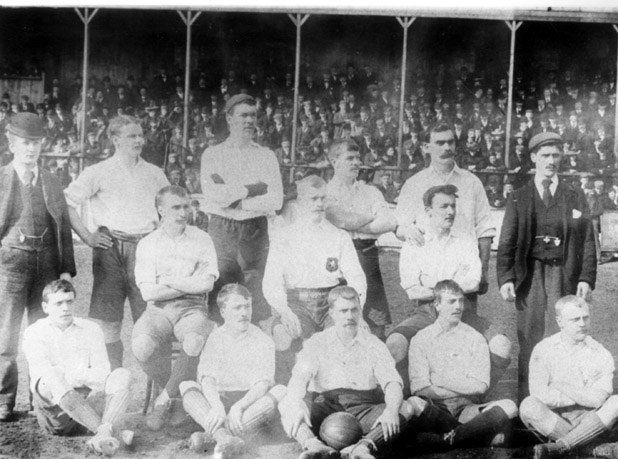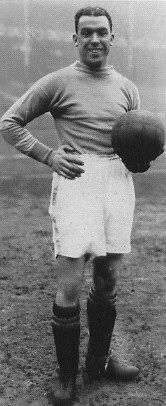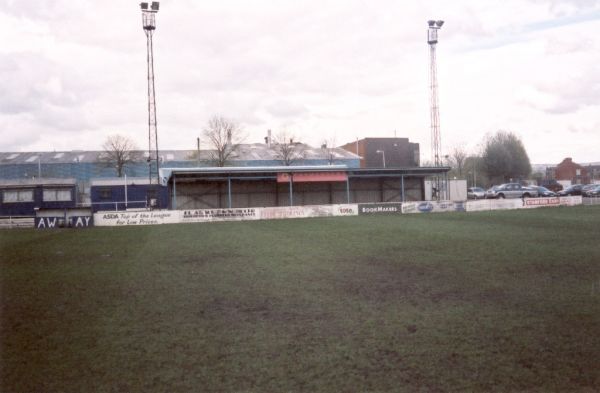Football in Ashton under Lyne a Short History

Football in Ashton under Lyne takes us right back to 1878 when Hurst Football Club was formed with the earliest recorded report coming in 1879. A game played on the 16th March 1879 against Hurst Red Star FC in their then colours of black and white stripes. The Robins as they are known now were then the Lambs and remained the lambs until 1923. Hurst FC better known as Ashton United Football Club played their first games at Holebottom in Smallshaw Ashton under Lyne, the ground was we assume on land adjacent to Holebottom and Coronation Road Ashton-under-Lyne.
The image shows the Hurst FC team that famously won the first-ever staging of the Manchester Senior Cup in 1885. They beat the then Newton Heath Football Club (Manchester United) 3-0 in the final. In the same season, they won a game in the second round of the FA Cup. Only to have the result annulled, losing their place in the third round of the competition; Hurst FC refused to play in a replay of the game. Only seven years later the club folded in 1892 after finishing ninth in the Ashton and District Football League.
Football in Ashton under Lyne Ashton North End
This brings us to the least recognised football in Ashton under Lyne events, the formation of Ashton North End FC. They played originally in the Ashton and District Football League and in 1892 were league champions. Eight places above their local derby rivals Hurst FC; the ground of Ashton North End was on Manchester Road Ashton under Lyne. As a football club, they only existed according to the information available for eight years; but they have a great history in a true footballing sense.

The great Herbert Chapman known better as the father of Arsenal played for them for a season 1895 to 1896 finishing tenth in the Lancashire League. Following him the equally great Arthur Wharton also known as the Old Street Tobacconist played for them for two seasons; between 1897 and 1899. In 1899 Mr Chapman and Mr Wharton were both playing for Stalybridge Rovers, another long-forgotten football club. Whether Arthur Wharton would have remained with Ashton North End is unknown but in 1899 the club filed for bankruptcy and was no more.
It can’t have been a coincidence that the newly formed football club in 1891 saw the possibility of divided loyalties in the town. This could have been the cause of the end of the first Hurst FC, but when Ashton North End FC went out of business in 1899. It appears there was a ten-year void in what could be viewed as top-class football at the time; as it was a decade before Hurst FC began again in 1909 playing in the then Manchester League. In their inaugural season, Hurst FC finished level on points with Salford United but lost the league playoffs 2-1. By 1912 the young club took football in Ashton under Lyne to new heights by winning the Manchester League.
Following this they joined Division 2 of the Lancashire Combination, but a world war ended all serious football in the town. In the interim, they joined the wartime league in the local area and then for the 1918-1919 season they returned to the Lancashire Combination for four seasons until they joined the Cheshire County League in 1923. It is at this point that Hurst FC changed colours from black and white stripes to the traditional red kit that the modern-day Ashton United Football Club play in, and of course, became the Robins.
Football in Ashton under Lyne Dixie Dean
 It is notable that in its two forms, Hurst FC and Ashton United FC have played football at Hurst Cross since 1880; making it one of the oldest Non-League grounds in the world. For fans of football, all turf is hallowed, but for football in Ashton, one of the most exciting days from a player’s perspective came in 1940. The then Hurst FC signed the great England International Dixie Dean at the end of his professional football career. So great was the name of Dixie Dean, a national footballing hero, that on his debut at Hurst Cross; 5600 football fans attended the game. His debut and short-lived tenure in Ashton ended in a 4-0 defeat at the hands of local rivals Stalybridge Celtic; the outbreak of the Second World War cut short Dixie Dean’s time with Hurst FC
It is notable that in its two forms, Hurst FC and Ashton United FC have played football at Hurst Cross since 1880; making it one of the oldest Non-League grounds in the world. For fans of football, all turf is hallowed, but for football in Ashton, one of the most exciting days from a player’s perspective came in 1940. The then Hurst FC signed the great England International Dixie Dean at the end of his professional football career. So great was the name of Dixie Dean, a national footballing hero, that on his debut at Hurst Cross; 5600 football fans attended the game. His debut and short-lived tenure in Ashton ended in a 4-0 defeat at the hands of local rivals Stalybridge Celtic; the outbreak of the Second World War cut short Dixie Dean’s time with Hurst FC
Football in Ashton under Lyne Ashton National
Another reason to celebrate football in Ashton under Lyne was the formation of a side known as Ashton National Football Club in 1920, they played their football at the aptly named National Stadium. Which later on became the home ground of Curzon Ashton in 1970, at the point it was taken over this must have been a derelict. Ashton National played all their football in the Cheshire County League, for a total of 19 years until the beginning of the Second World War in 1939. They were known as Ashton National due to the fact they were financed by the National Gas and Oil Engine Company of Ashton under Lyne.
They were a football side with excellent finances and due to the fact, they were a Non-League outfit; the club were not shackled by the Football League’s maximum wage rules. This meant in 1932 the club signed Scottish International Alec Jackson from First Division Chelsea and paid him almost double his earnings from Chelsea FC. He came to play his football in Ashton under Lyne for the huge sum of £15 per week; that was £7 per week more than he earned playing for Chelsea. Allowing for inflation his earnings in 2019 would be equivalent to almost £1100 per week.
Ashton National sadly did not return to football in Ashton under Lyne following the end of the Second World War. Their keeper Walter Cornock though joined Hurst FC when the club ended, playing fourteen games for them in 1940. It is worth noting that Mr Cornock was also a first-class cricketer who played for Leicestershire. Other clubs gave up quality players to this local Non-League outfit; and they include Manchester United, Bolton Wanderers, Huddersfield Town and West Bromwich Albion.
Football in Ashton under Lyne Ashton United
The outbreak of the Second World War also cut short Dixie Dean’s time with Hurst FC and the next time the team appeared in any league was for the 1945-1946 season when they played in the Cheshire County League. Two events in 1947 changed Hurst FC forever, they became Ashton United Football Club and then applied to join the Football League. Sadly they were overlooked for this privilege for what became the reason many great non-league clubs were denied entry into the professional game. Entry into the Football League was for long decades a matter of clubs being re-elected by existing members; making it a closed shop to non-league football.
This meant a return to the Lancashire Combination in 1948, where they remained until resigning in 1961. Ashton United then applied to re-join the Cheshire County League but were defeated in a ballot by Altrincham and Wigan Athletic. The result of this was a return to the Lancashire Combination Football League; but due to Division One now being filled they dropped to the second division, A successful season in the Lancashire Combination Football League Division 2, saw them returned to the league’s top-flight as champions in 1962.
Football in Ashton under Lyne Curzon Amateurs
Before the next major change for Ashton United FC came about, a new Ashton side was formed by the amalgamation of two of Ashton under Lyne’s amateur football sides. Curzon Road Methodists FC and Ashton Amateurs FC became Curzon Amateurs Football Club in 1963. It is not clear when the club changed from Curzon Amateurs to Curzon Ashton FC but that is how they are known to all of us today. In their first season as a newly formed football club, they were Manchester Amateur League Division 1 champions; runners-up in the following season and then champions again in the 1965/66 season.

As Curzon Ashton started to make a name for themselves locally, Ashton United switched from the Lancashire Combination Football League to the Midland Counties League I 1964. In the two seasons they played in this competition the league was won by Lockheed Leamington and better known to many, Worksop Town in Ashton United’s second season in the division. In 1966 Ashton United FC returned to more local football, joining the Cheshire County League; and remained there until it amalgamated with the Lancashire Combination Football League to form The Northwest Counties League in 1982.
For many years Curzon Ashton Football Club followed in the wake of their football in Ashton under Lyne rivals Ashton United. They had many occasions before the 21st century where they looked like breaking down the door and matching their neighbours. In 1979 Curzon Ashton bettered Ashton United’s best performance in the FA Vase by reaching the semi-final of the competition. Sadly for the fans, this resulted in a 4-0 defeat over two legs to Stamford FC; who went on to win the final against Guisborough 2-0.
Following this Curzon began their push to attain a position in the Northern Premier League and there were some near misses along the way. During that time Curzon was moved from the Northwest Counties League to the Northern Counties East Division. So for the season of 1997-1998, they were playing teams from outside the Northwest region. This must have placed the club under severe financial pressure due to increased travel costs; and as a result, they finished second bottom of the table. Luckily in the following season, they were returned to their old stomping ground and returned to the Northwest Counties League.
Football in Ashton under Lyne Changing Fortunes
As Curzon was expressing their ambitions to forward football in Ashton under Lyne, Ashton United were also fighting to attain the Northern Premier League Premier Division. In 1991 Ashton United were promoted to the Northern Premier League Division One, and a decade later they finally made it to the Premier Division via the playoffs. They pipped Bamber Bridge in the 2002 playoff final 2-1 to earn a position in the league that both Ashton Clubs had eyes on. This led Ashton United to what was then Conference North as the structure of non-League football changed dramatically.
The real turning point for Curzon Ashton FC came in 2004 when the site of their home ground the National Stadium was sold for housing. Tameside Council during this process took on the mantel of landlords by building the Tameside Stadium, completed in 2005 and opened in September by Sir Alex Ferguson. The installation of a FIFA-graded artificial surface on the training ground changed the fortunes of this football club. Football in Ashton under Lyne started to change as a resurgent Curzon Ashton began to show their teeth. In 2007 Curzon again reached the Semi-Final of the FA Vase but only to fall to another eventual winner of the Trophy; in this case Truro City.
Football in Ashton under Lyne Top of the Pile
In the same season, they were finally promoted to the level of football they had sought for so many years. Curzon Ashton were members of the Northern Premier League Premier Division due to their relegation in the first season. They were playing at the same level as their often most bitter rivals Ashton United FC, and for Ashton United, this was going get a whole lot worse in the coming years. In 2015, the two clubs met in the playoff final for a place in the National League North. At the end of extra time, there was nothing to separate the two football clubs, penalties saw Curzon Ashton leap-frog United to the league above.
Following this Curzon Ashton went from strength to strength, a great FA Cup run followed before Ashton United after two more attempts made it to the same division. This though was short-lived as they were relegated in the 2018-2019 season while Curzon with a strong mid-table finish remains in National League North. For the time, all of Curzon Ashton’s Tameside football
rivals are below them; and football in Ashton under Lyne is riding high at the top of the pile. Next Season Curzon will fight to retain this prize while Ashton United, Hyde United and Stalybridge Celtic battle to return to a higher level.
Our hope as a business is that by presenting these blogs to the wider public, we reflect the sense of community felt by all at Besseges (Valves, Tubes & Fittings) Ltd. Ashton under Lyne is where our business is based as are many members of our staff. If you have any comments or updates you would like to share with us; please use the contact link to get in touch. As always we would like to express our gratitude to the Tameside Image Archive for their continued support in providing the excellent images used in this piece.
Register For An Account
Save & manage your details, access invoices, and enjoy a quicker shopping experience!